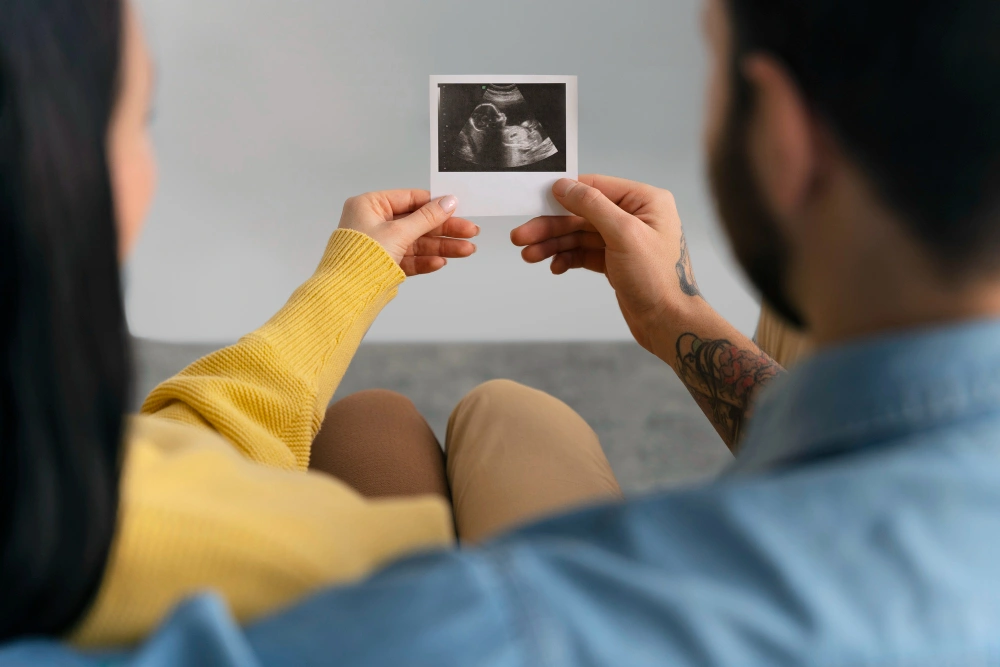
Moms may often hear the term non-developing fetus. Many assume this condition means the fetus is growing slower than the actual gestational age. In fact, this term is also known as a blighted ovum or anembryonic pregnancy, which is a condition where the gestational sac forms, but the embryo does not develop.
This pregnancy often surprises and confuses Moms because its early symptoms are similar to a normal pregnancy. Therefore, it is important for Moms to understand the causes, signs, and treatment.
What Is a Non-Developing Fetus?
A non-developing embryo is a condition where a fertilized egg successfully attaches to the uterine wall but fails to develop into an embryo. As a result, the gestational sac appears empty during an ultrasound examination.
This condition is usually detected in the first trimester, especially when the fetal heartbeat is not detected at 6–10 weeks of pregnancy.
According to research in the New England Journal of Medicine (1993), most cases of fetal development failure are caused by chromosomal abnormalities that prevent the embryo from growing normally.
Causes of Non-Developing Fetus
The condition of a non-developing fetus or empty pregnancy (blighted ovum) can be caused by various factors. It is important for Moms to understand that most causes occur naturally and are not due to any fault of their own. Here are some of the main causes often associated with anembryonic pregnancy:
1. Chromosomal Abnormalities
Chromosomal abnormalities are the most common cause. According to research in the New England Journal of Medicine (1993), approximately 50–60% of cases of fetal development failure occur due to genetic abnormalities since the fertilization process. Unhealthy eggs or sperm can cause the zygote to fail to divide properly.
This condition can occur randomly, so it does not always recur in subsequent pregnancies. However, the mother's age also affects the risk. Women over the age of 35 have a higher likelihood of experiencing chromosomal abnormalities in their eggs.
2. Placenta Issues
The placenta functions as a "bridge of life" between the mother and the fetus. If the placenta does not form properly or experiences functional disturbances, the nutrients and oxygen that should reach the fetus become disrupted. As a result, embryonic growth halts from the early stages of pregnancy.
Several studies indicate that abnormalities in placental formation may be associated with hormonal disorders or blood circulation in the uterus.
3. Infections in Pregnant Women
Certain infections can disrupt embryo development. For example:
-
Toxoplasmosis, an infection from a parasite often found in cat feces.
-
Rubella (German measles), which can cause abnormalities in the fetus.
-
Viral infections such as CMV (cytomegalovirus).
The infection can cause the embryo not to develop or increase the risk of miscarriage. Therefore, before planning a pregnancy, Moms are advised to undergo a TORCH test (Toxoplasma, Rubella, CMV, Herpes).
4. Environmental Factors
Exposure to hazardous substances also affects fetal development. Some of them include:
-
Cigarettes and cigarette smoke that can reduce the quality of oxygen in the blood.
-
Alcohol and drugs that can damage the cell division process.
-
Exposure to hazardous chemicals such as pesticides, heavy metals, or certain medications without a doctor's supervision.
All these factors can increase the risk of a blighted ovum.
5. Maternal Health Issues
Certain medical conditions can also be the cause of fetal development issues, including:
- Hormonal disorders, such as polycystic ovary syndrome (PCOS), which reduces egg quality.
- Autoimmune diseases, in which the body's immune system attacks its own tissues, including the fetus.
- Uncontrolled diabetes, which can interfere with the supply of nutrients to the fetus.
- Hypothyroidism, a thyroid hormone disorder that affects reproductive hormone balance.
In addition, a history of recurrent miscarriages can also be a risk factor that needs attention.
6. Mother's Age
As age increases, the quality of eggs also declines. Women who become pregnant at the age of 35 and above are more susceptible to chromosomal abnormalities, which ultimately increases the risk of the fetus not developing.
Psychological Impact
Experiencing an anembryonic pregnancy can be very difficult for Moms and their partners. Feelings of sadness, disappointment, and even trauma often arise. Support from family, partners, and psychological counseling is very important so that Moms do not feel alone.
According to research in Human Reproduction Update (2016), women who experience miscarriages, including fetal demise, are at higher risk of depression and anxiety if they do not receive emotional support.
Can It Be Prevented?
Most cases occur due to random genetic abnormalities, making them difficult to completely prevent. However, Moms can reduce the risk by:
-
Maintaining a healthy lifestyle before pregnancy.
-
Consuming a balanced nutritious diet.
-
Avoiding cigarettes, alcohol, and harmful drugs.
-
Regularly undergo health check-ups and pregnancy ultrasounds.
-
Managing chronic diseases such as diabetes or hypertension.
Before trying to conceive again, doctors usually recommend waiting 1–2 menstrual cycles for the body and emotional condition to recover.
A non-developing fetus or blighted ovum (anembryonic pregnancy) is a condition where the gestational sac forms without an embryo. The main cause is chromosomal abnormalities, but other factors such as placental issues, infections, and maternal health also play a role.
Moms need to recognize the signs of a blighted ovum, such as cramps, bleeding, declining hCG levels, and an empty gestational sac on ultrasound. If diagnosed, there are several treatment options, ranging from waiting for it to resolve naturally, medication, to curettage.
Most importantly, do not forget the psychological aspect. Support from loved ones and regular medical check-ups will help Moms face this condition more strongly.







